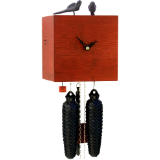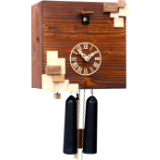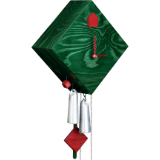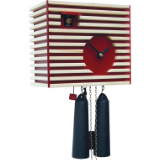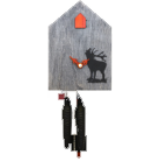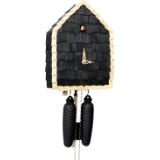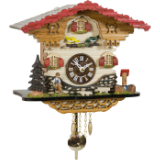History of Black Forest Clocks - Clock production
Today it is no longer possible to determine exactly when the first Black Forest Clock, the mother of all cuckoo clocks, was built. Sometimes the period from 1670-1720 is mentioned as the beginning of Black Forest clock production. Other sources mention the year 1640 or even 1629. What is certain is that the clock industry spread rapidly in the 18th century. At that time, Furtwangen was the center of clock production.
The preferred material - partly for legal reasons - was initially wood, which was used both for cases and mechanisms. The people of the Black Forest had a long tradition of working with wood, and they also had a good feel for products that could provide the rural population a promising additional income. The beginnings of Black Forest clockmaking were rather pragmatic and rustic: an early forerunner of today's clocks was the Waagbalkenuhr, a crude wooden clock mechanism in which a wooden beam that swung back and forth set the time. It had only one hour hand, and the weight was a stone. These early Black Forest clocks had a 12-hour movement. Later, metal/brass gradually replaced the wooden components of the movement.
The enterprising people of the Black Forest soon distributed their clocks along the international trade routes used by the local glass industry. By the way, it was probably through these routes that the first clocks from Bohemia or elsewhere arrived in the Black Forest on the backs of the glass carriers. The profession of the "glass carrier" was highly respected and required the highest trustworthiness due to the preciousness of the products.
So Black Forest clock dealers soon settled along these routes, stored their clocks centrally and sold them successfully on the local markets. The Black Forest wooden clocks were cheap and reliable. The clock carrier, with his typical high frame on his back can still be found today as a decorative element on some cuckoo clocks. As time passed by, more and more people could afford to buy clocks of all kinds and the demand grew by leaps and bounds.
At the same time, in the 18th and 19th centuries, the time required for the production of clocks was greatly reduced, due to the invention of the spindle drill and the emergence of specialists in ancillary trades. Frame makers, sign painters and chain makers shared the work and in turn rationalized and improved the production processes. The number of clocks that each worker could produce in a week increased sixfold over the course of 100 years. Yet, cuckoo clocks were not the most popular Black Forest clocks in the beginning, but the lacquer shield clocks (Schilderuhren), which accounted for about half of the total production.
The years 1800-1840 were years of boundless growth. Up to 600,000 clocks were produced per year and shipped all over the world. Increasingly frequent distribution and logistical problems were solved by wholesale companies. The individual clockmaker could not and did not want to take care of these business areas. He was preoccupied with the production of the clocks that were in demand, which became more and more complex.
After the crisis years and many economic changes production reached approx. 1.8 million in 1870 and in 1905 approx. 5.8 million clocks. In 1905, 50% of all large clocks exported worldwide came from the Black Forest. This increase in production was achieved by replacing the small manufacturers by large clock factories.
After the two world wars, the boom of the Black Forest clock production collapsed and could never again reach the overwhelming sales figures of earlier centuries. Plastics and and quartz mechanisms changed the world of clocks from the 1970s onward in a drastic way. Today, signs of a turnaround are emerging. In the course of a return to old traditions, handcrafted quality is in demand again, and handcrafted clocks are also in high demand internationally. Especially THE Black Forest clock par excellence, the cuckoo clock, is experiencing a worldwide revival.
